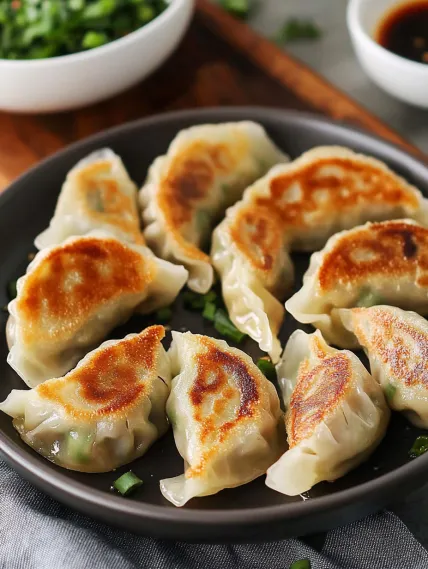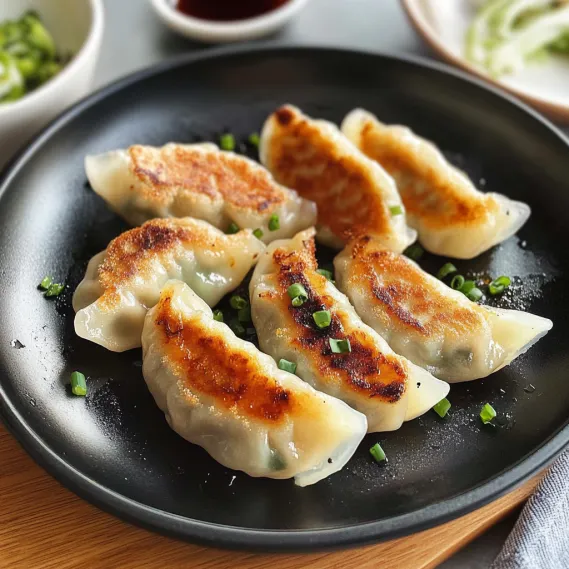 Pin it
Pin it
Prawn Gyoza (Pan-Fried Dumplings) bring homemade Japanese prawn gyoza to your kitchen. These dumplings feature succulent prawns, crisp cabbage, and aromatic chive fillings wrapped in thin dough and pan-fried to crispy golden perfection. Each dumpling delivers a delightful contrast between the juicy filling and crispy bottom. Served with a simple dipping sauce, these irresistible bites make perfect appetizers or savory snacks that everyone will love.
I discovered my love for gyoza during my first trip to Japan and was determined to recreate them at home. After several experiments, this recipe captures the authentic flavors and textures that made me fall in love with these dumplings. My family now requests these regularly, and guests always ask for the recipe.
Essential Ingredients and Selection Tips
- Prawns/Shrimp: Choose fresh or frozen, making sure they're peeled and deveined. Pat dry thoroughly before mincing for best texture.
- Gyoza Wrappers: Thinner than Chinese dumpling wrappers. Find them at Asian markets in the refrigerated section.
- Cabbage: Asian or sweetheart varieties work best for their tender leaves. Napa cabbage makes a great substitute.
- Garlic Chives: Adds distinctive garlicky flavor. Regular chives or green onions can substitute in a pinch.
- Seasonings: The combination of soy sauce, sesame oil, mirin, garlic, and ginger creates authentic Japanese flavor.
I've found that adding a small amount of cornstarch to the filling mixture helps bind everything together, preventing the filling from becoming watery during cooking. This creates a juicier, more cohesive filling that stays in place when you bite into the gyoza.
Detailed Cooking Instructions
- Step 1: Prepare the Cabbage
- Finely chop half a small cabbage into very thin strips, then place in a bowl and sprinkle with 1/2 teaspoon salt, mixing well. Let it sit for 10-15 minutes to draw out excess moisture, then squeeze firmly between your hands or in a clean kitchen towel to remove as much water as possible, which prevents soggy dumplings.
- Step 2: Make the Filling Mixture
- Finely chop 300g prawns with a sharp knife or pulse in a food processor until minced but not pasty. In a large mixing bowl, combine the minced prawns, drained cabbage, and 1/4 cup finely chopped garlic chives. Add 1 tablespoon soy sauce, 1 tablespoon sesame oil, 1 tablespoon mirin, 1 clove minced garlic, 1/2 teaspoon grated ginger, 1/4 teaspoon white pepper, and 1 tablespoon cornstarch, then mix thoroughly until sticky.
- Step 3: Fold the Gyoza
- Place one gyoza wrapper in your left palm and add a tablespoon of filling to the center, being careful not to overfill. Dip your finger in water and wet the entire edge of the wrapper. Fold the wrapper in half over the filling and pinch it closed at the center point. Create 3-4 pleats along each side by folding the wrapper toward the center, pressing firmly to seal and creating the characteristic crescent shape.
- Step 4: Arrange Before Cooking
- Place the folded dumplings on a tray lined with parchment paper, making sure they don't touch each other to prevent sticking. Cover with a damp kitchen towel to keep them from drying out while you finish folding the remaining dumplings.
- Step 5: Cook to Crispy Perfection
- Heat 1 tablespoon of neutral oil in a large non-stick skillet over medium heat until shimmering. Arrange the gyoza in the pan, pleated side up, making sure they touch slightly. Fry undisturbed for 2-3 minutes until the bottoms become golden brown and crispy. Add 1/3 cup water to the pan (it will sizzle vigorously), immediately cover with a lid, and steam for 3-4 minutes until the wrappers become translucent and the water has evaporated.
 Pin it
Pin it
My first attempt at making gyoza resulted in torn wrappers and leaking filling. I learned that keeping the filling relatively dry and not overfilling the wrappers makes all the difference. Now I can fold them quickly with consistent results, creating that perfect seal that holds everything together during cooking.
Simple Dipping Sauce
Create a perfect accompaniment by mixing 3 tablespoons soy sauce, 1 tablespoon rice vinegar, 1/2 teaspoon sugar, and 1 teaspoon chili oil in a small bowl. The tangy-spicy sauce complements the dumplings beautifully. For milder taste, substitute lemon juice for vinegar or omit chili oil altogether.
 Pin it
Pin it
Origins and Cultural Significance
Gyoza originated in China as 'jiaozi' before being adapted in Japanese cuisine. Japanese versions typically feature thinner wrappers and more delicate seasonings. These dumplings are enjoyed as appetizers, side dishes, or casual snacks in Japan, often paired with beer or as part of a larger izakaya-style meal.
Perfect Pairing Suggestions
Complete your Japanese feast by serving gyoza alongside miso soup, steamed rice, and simple vegetable sides like cucumber salad. For a proper izakaya experience, pair with cold Japanese beer or hot green tea. The gyoza's rich flavor contrasts beautifully with lighter, refreshing sides.
Make-Ahead and Storage Tips
Prepare gyoza in advance by freezing them uncooked on a tray until solid, then transferring to freezer bags where they'll keep for up to three months. Cook directly from frozen by adding an extra minute to the steaming time. Cooked gyoza stay fresh in the refrigerator for 2-3 days.
Common Variations to Try
Experiment with different fillings like chicken, pork, or vegetarian options with mushrooms and tofu. Add grated carrot or finely diced water chestnuts for extra crunch. For a spicier version, incorporate a small amount of kimchi into the filling or add red chili flakes to the mixture.
 Pin it
Pin it
Chef's Helpful Tips
- For extra-crispy bottoms, mix 1 teaspoon flour with the water when steaming
- Cool the filling slightly before wrapping to make handling easier
- Keep folded gyoza covered until cooking to prevent wrappers from drying out
- If gyoza stick to the pan, add a few drops of water and gently loosen with a spatula
- For a complete meal, serve three or four gyoza per person as an appetizer or ten to twelve as a main dish
I've been making these prawns gyoza for years, and the biggest improvement came when I started properly draining the cabbage. This simple step transformed my gyoza from good to restaurant-quality, creating that perfect juicy-but-not-watery filling that makes these dumplings so addictive.
Frequently Asked Questions
- → Can I use a different filling instead of prawns?
- Absolutely! You can substitute the prawns with ground pork, chicken, or a mixture of mushrooms for a vegetarian option. If using pork or chicken, use about 300g and follow the same seasoning instructions. For a vegetarian filling, try 200g of finely chopped mushrooms (shiitake works well) combined with extra cabbage and chives, plus a tablespoon of crumbled tofu for texture.
- → I'm having trouble folding the gyoza. Any tips?
- Gyoza folding takes practice! Start by using just a small amount of filling (about 1 teaspoon) until you get comfortable with the technique. Make sure your fingers are dry but the edges of the wrapper are slightly wet. Start by pinching the middle of the half-circle to seal, then work your way outward creating small pleats in one direction. Don't worry if they're not perfect – they'll still taste delicious!
- → Can I steam or boil these gyoza instead of pan-frying?
- Yes, these gyoza can be cooked in several ways. To steam them, arrange in a steamer lined with cabbage leaves or parchment paper and steam for 8-10 minutes until wrappers are translucent. To boil, gently drop them in boiling water and cook until they float to the surface, then continue for another 1-2 minutes. However, pan-frying creates the traditional crispy bottom that makes gyoza especially delicious.
- → Where can I find gyoza wrappers?
- Gyoza wrappers can be found in the refrigerated section of Asian grocery stores, international supermarkets, or sometimes in the international food section of larger grocery chains. Look for round wrappers labeled as 'gyoza,' 'dumpling,' or 'potsticker' wrappers. If you can't find them, wonton wrappers can work in a pinch, though they're usually square and thinner.
- → How can I tell when the gyoza are fully cooked?
- Properly cooked gyoza have three indicators: 1) The bottom is golden brown and crispy, 2) The wrapper appears somewhat translucent rather than doughy, and 3) The internal temperature should reach at least 165°F (74°C) if using meat. For prawn gyoza, the filling should be opaque and firm. If in doubt, you can always remove one and cut it open to check.
